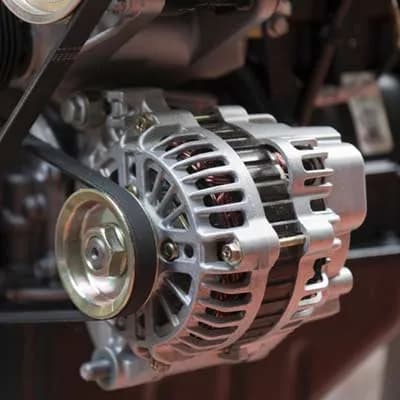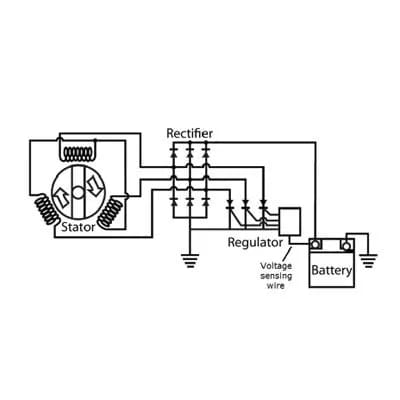2-Stroke vs. 4-Stroke Outboard Motors
Discover the differences between 2-stroke and 4-stroke outboard motors. Learn the pros and cons of these outboard motors by reading here!
All motorcycles require electricity for functions ranging from ignition to powering accessories like GPS and heated grips. The electrical power can be generated in different ways, with alternators and stators being key components in this process.
A motorcycle stator is a crucial part of the motorcycle charging system, working alongside a rectifier/regulator to convert mechanical motion into alternating current (AC) and then into direct current (DC) for the motorcycle electrical systems.
Unlike many cars and trucks that use an all-in-one-style alternator unit mounted externally, most motorcycles use a combination of a stator and a rectifier/regulator for power generation, with very few motorcycles having automotive-style external alternators.
The main difference between a stator and an alternator in the context of motorcycles is that a stator, combined with a rectifier/regulator, generates the necessary DC power internally, whereas an automotive-style alternator is a self-contained unit that generates DC power externally.
Testing a motorcycle stator is an important diagnostic step when dealing with starting issues or battery charging problems. Experienced technicians use a multimeter to conduct tests both with and without the engine running to ensure the charging system is functioning properly before replacing a battery.
Whether you’re a motorcycle enthusiast or an aspiring technician, it’s important to know about the different types of power sources for motorcycles. Keep reading to learn about motorcycle alternators, stators and the differences between these two devices.
The term “alternator” is commonly associated with the power-supply device commonly seen on cars and trucks. It turns motion into current. It is an all-in-one-style unit that supplies the needed power to the vehicle.

Image credit Krishna Auto Electric
While the term alternator is commonly associated with automotive-style units, the official definition is a device that creates alternating current (AC) power from mechanical motion.
A “motorcycle stator” is one component of the system that generates power for a motorcycle. Motorcycles generate power like cars, however, they do it in a slightly different fashion. Rather than being an externally mounted unit, a stator is positioned inside the engine and looks like this:

Image credit DB Electrical
As you can see in the picture above, a wire will travel through the engine case to an external rectifier/regular, which converts alternating current into direct current.

Image credit DB Electrical
The rectifier/regulator is also responsible for maintaining the proper current as to avoid overcharging the battery and other dangerous issues. As engine speed increases, the stator will put out more and more power, and if left unregulated, can cause damage.
The stator of a motorcycle serves as a crucial component of the electrical system, responsible for generating electrical power to recharge the battery and power the motorcycle's electrical components.
It operates through the principle of electromagnetic induction, where coils of wire within the stator produce an alternating current when the engine is running. This alternating current is then converted into direct current by the motorcycle's regulator/rectifier to charge the battery and supply power to the lights, ignition system and other electrical systems on the motorcycle.
The stator's efficient functioning is vital for maintaining electrical power while riding and ensuring the overall performance of the motorcycle's electrical system.
The alternator in a motorcycle helps with generating electrical power to keep the battery charged and run the electrical components of the bike. It also uses the principle of electromagnetic induction. This alternating current produced is converted into direct current by the rectifier within the motorcycle's electrical system.
The alternator not only maintains the battery's charge but also powers the lights, ignition system and other electronic accessories while the motorcycle is running. Its efficient functioning is essential for ensuring a reliable and consistent power supply to all electrical systems on the motorcycle.
The simple answer to this question is yes—however, very few automotive-style external all-in-one alternators exist on motorcycles. Rather, a stator and rectifier/regulator handle the power generation task.
To generate electricity, three things are required: motion, a magnet and a coil of wire. The motion comes from the rotational nature of an engine, and the magnet and coil of wire are added to complete the requirements for generating power.
Additionally, motorcycles need DC, or direct current, to power the electrical systems. Motorcycle alternators produce AC, or alternating current, requiring the rectifier/regulator to complete the system.
A motorcycle stator is a device that takes the existing mechanical motion of an engine and creates an electrical current. Simply put, a stator works together with a rectifier/regulator to accomplish the same outcome as an alternator—to generate the DC power required to operate the motorcycle, ATV, side-by-side, etc.
The stator is the coil of wire housed inside the engine case. A magnet on a shaft spins within the stator, creating alternating current. The current travels along fairly heavy-gauge wire through the case and into the rectifier/regulator which converts it to DC power, and at a consistent output.
When trying to understand the difference between a stator and an alternator, we first need to identify what specifically we are comparing.
A motorcycle stator is a component of the electrical system that, when combined with a rotating magnet, creates an AC current. Stators are inside the engine case.
An automotive-style alternator is a fully self-contained, externally mounted unit that creates a DC current. Another difference between stators and automotive-style alternators is the type of magnet used. Stators use a permanent magnet, and automotive alternators use an electromagnet.
As stated above, a stator is one component of the motorcycle charging systems. Motorcycle alternator refers to a collection of components that includes the stator, but also includes magnets and a rectifier/regulator (devices that convert AC to DC current and maintain steady output).

If a dead motorcycle battery causes a starting issue, we often assume the battery is faulty. Typically, this is correct, as motorcycle batteries fail more frequently than stators fail. However, before assuming the battery is at fault and installing a brand new one, an experienced technician will rule out the charging as the cause of the problem.
If the motorcycle charging system is not properly charging the battery, simply replacing it will not solve the issue. Additionally, a discharged battery will need to be brought up to full charge prior to static or load testing it.
A motorcycle technician uses a multimeter to test a stator, either with or without a running engine. With the engine off, a technician can test for a broken winding wire. With the engine running, a technician can test the voltage going into the battery. Using a series of tests and chronological steps, a technician can rule out faults in the charging system, determining if the battery is ultimately the cause of the no-start scenario.

Motorcycle and powersports technicians regularly work with and test electrical system components. Understanding how the components interact with one another is critical for effective diagnosis and repair. Technicians won’t often see automotive-style alternators on motorcycles; however, understanding how they work is valuable information to have.
Stators, on the other hand, are a component that will require testing and a thorough understanding of how they work. As with any system on a vehicle, once it’s understood how they should work and how they typically fail, a technician will be more comfortable and confident with diagnosing, servicing and replacing components like motorcycle carburetors.
Wondering what types of jobs motorcycle technicians can pursue? Check out our career guide.
In Universal Technical Institute's 48-week Motorcycle Technician Training program, you’ll be taught the foundations of motorcycles, ATVs, side-by-sides, snowmobiles and personal watercraft to prepare for a career as a motorcycle technician.1 To learn more, visit our program page and request information to get in touch with an Admissions Representative today.
Universal Technical Institute of Illinois, Inc. is approved by the Division of Private Business and Vocational Schools of the Illinois Board of Higher Education.